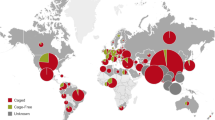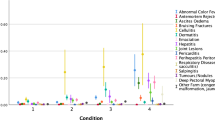Abstract
Researchers are increasingly using the domestic hen (Gallus gallus) as an animal model for ovarian cancer. The authors analyzed mortality rates of two large flocks of older hens that were being used for ovarian adenocarcinoma studies. All hens were fed the same maintenance diets, though some hens in each flock received experimental chemopreventive treatments. Per the request of a collaborating institution, partway through the study, the authors started to remove the hens in one of the flocks for cage changing once every 4 weeks. After the authors began cleaning some of the hens' cages, the mortality rate in this flock increased significantly. Throughout the study, within each flock, hens in the treatment and control groups had similar mortality rates. These results suggest that regularly cleaning the cages of older hens may not promote better welfare or improve flock mortality.
This is a preview of subscription content, access via your institution
Access options
Subscribe to this journal
We are sorry, but there is no personal subscription option available for your country.
Buy this article
- Purchase on Springer Link
- Instant access to full article PDF
Prices may be subject to local taxes which are calculated during checkout
Similar content being viewed by others
References
Johnson, K.A. The standard of perfection: thoughts about the laying hen model of ovarian cancer. Cancer Prev. Res. (Phila. Pa) 2, 97–99 (2009).
Hakim, A.A. et al. Ovarian adenocarcinomas in the laying hen and women share similar alterations in p53, ras, and HER-2/neu. Cancer Prev. Res. (Phila. Pa) 2, 114–121 (2009).
Vanderhyden, B.C., Shaw, T.J. & Ethier, J.F. Animal Models of ovarian cancer. Reprod. Biol. Endocrinol. 1, 67 (2003).
Wilson, J.E. Adeno-carcinomata in hens kept in a constant environment (abstract). Poult. Sci. 37, 1253 (1958).
Fredrickson, T.N. Ovarian tumors of the hen. Environ. Health Perspect. 73, 35–51 (1987).
Casagrande, J.T. et al. “Incessant ovulation” and ovarian cancer. Lancet 314, 170–173 (1979).
Rodriguez, G.C. et al. in Ovarian Cancer (eds. Jacobs, I.J. et al.) 161–170 (Oxford University Press, 2002).
Institute for Laboratory Animal Research. Guide for the Care and Use of Laboratory Animals (National Academies Press, Washington, DC, 1996).
Federation of Animal Science Societies. Guide for the Care and Use of Agricultural Animals in Agricultural Research and Teaching 2nd edn. (Federation of Animal Science Societies, Savoy, IL, 1999).
Anderson, K.E. Final Report of the Thirty Second North Carolina Layer performance and Management Test: Production Report 32, July 1998. (North Carolina State University, Cooperative Extension Service, Raleigh, NC, 1998). Available: http://www.ces.ncsu.edu/depts/poulsci/tech_manuals/layer_reports/32_final_report.pdf.
Anderson, K.E. Final Report of the Thirty Fifth North Carolina Layer Performance and Management Test 35, May 2005. (North Carolina State University, Cooperative Extension Service, Raleigh, NC, 2005). Available: http://www.ces.ncsu.edu/depts/poulsci/tech_manuals/layer_reports/35_final_report.pdf.
Anderson, K.E. & Havenstein, G.B. Effects of alternative molting programs and population on layer performance: results of the Thirty-fifth North Carolina Layer Performance and Management Test. J. Appl. Poult. Res. 16, 365–380 (2007).
Author information
Authors and Affiliations
Corresponding author
Ethics declarations
Competing interests
The authors declare no competing financial interests.
Rights and permissions
About this article
Cite this article
Anderson, K., Mozdziak, P. & Petitte, J. The impact of scheduled cage cleaning on older hens (Gallus gallus). Lab Anim 39, 210–215 (2010). https://doi.org/10.1038/laban0710-210
Received:
Accepted:
Issue Date:
DOI: https://doi.org/10.1038/laban0710-210




